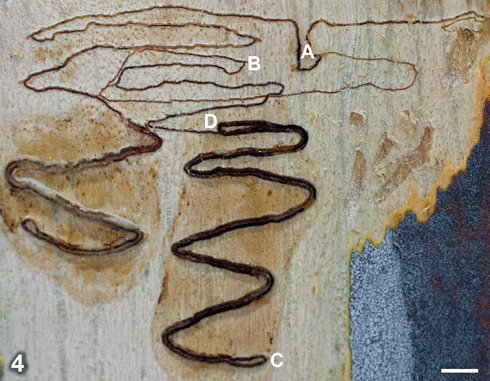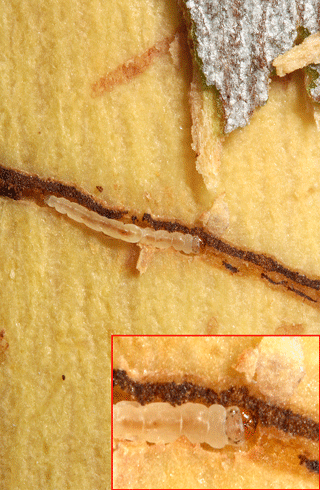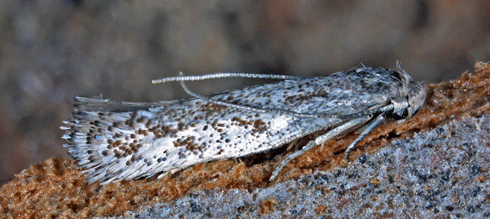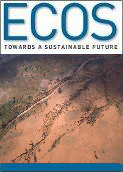
|
Published: 28 November 2012
Retirees find link between ‘bush graffiti’ and Gondwana
A team of retired scientists working at CSIRO has completed a remarkable investigation into the iconic ‘scribbles’ found on smooth-barked eucalypts throughout southeastern Australia. Their work took them deep into the little known world of Australia’s scribbly gum moths.
The distinctive ‘scribbles’ on scribbly gum eucalypts have long been an Australian icon. They inspired Australian poet Judith Wright’s 1955 poem ‘Scribbly-Gum’, and May Gibbs made them a feature of her classic series of children’s books, Snugglepot and Cuddlepie.
But, for as long as they’ve been iconic, they’ve also been an enigma. The scribbles were first thought to be caused by beetle larvae and, although an English school teacher discovered in 1934 that moth larvae were the real culprits, the misconception has endured.
Now, new research facilitated by CSIRO – involving a collaboration between some of Australia’s most respected entomologists – has finally verified the identity of these ‘bush graffiti’ artists.
The respected entomologists are former CSIRO scientists, well into their retirement but able to continue pursuing the science they love through CSIRO’s Honorary Fellowship program.
Marianne Horak, Ted Edwards AM (Member of the Order of Australia) and 96-year-old Max Day AO (Officer of the Order of Australia) donate their time and passion for insects at CSIRO’s Australian National Insect Collection in Canberra. Another team member, Celia Barlow, on whose property much of the work was done, added the botanical knowledge.
The researchers began the detective work after schoolgirl, Julia Cooke – with the help of Ted Edwards – discovered different and unique ‘dialects’ present in different scribbles, indicating that a range of species was likely to be responsible. Julia and Ted published their work in 2007.1
To find out more about the scribble ‘dialects’, the researchers conducted detailed studies into the biology and systematics of the scribbly gum moths. Collaborating researchers at CSIRO and Queensland University of Technology provided DNA and carried out microscopic analyses to help confirm the findings.
What the team discovered was remarkable. Eleven new species of moths have been described, several of which turned out to be behind the scribbles, in addition to the original species of scribbly gum moth described in 1934 – Ogmograptis scribula. The new species that do not appear to make ‘scribbles’ on smooth-barked eucalypts are thought to feed hidden in rough-barked eucalypts and are therefore not as visible.2
The team also pieced together the mechanism by which the moth larvae make the distinctive scribbles and in the process have uncovered a unique ecological interaction that occurs between tree and moth (see the image and caption below).

|
|
The life cycle of scribbly gum moths can be seen in their tracks. Point A: Larva chews through underside of egg and through outer bark to reach the bark layer where the future cork cambium will form. There it turns to bore along this layer, possibly moulting to its 2nd life stage. Track A–B: Track is narrow, irregular, often meandering and occasionally crossing itself. Larva feeds on bark tissue, apparently moulting to its next stage part-way between A and B. Point B: Beginning of series of regular track zig-zags; larva moults near point B. Track B–C: First pass of doubled zig-zags which don’t cross each other; larva feeds on bark tissue. Point C: First turning loop of doubled track. Track C–D: Return track of doubled zig-zags, either closely parallel in separate track (O. scribula) or joining and enlarging initial track (O. racemosa); larva feeds on bark tissue. Point D: Second turning loop; larva (after turning) moults at point D to its final stage and now has legs. Track D–E: Larva returns along the way it came towards point C along the doubled track. It now feeds on the highly nutritious callus tissue that has filled the track, as well as the incorporated frass from the earlier passage(s). Point E: Emergence hole where mature larva bores to the surface somewhere between points D and C (not visible after outer bark has abscised). The caterpillar spins a cocoon at the base of the tree and turns into a moth. (Adapted from Horak et al. 2012)3 |
Not only has this team described eleven new species and solved the mystery of how the scribbles are made, but they have also helped redraw the moth family tree.
The researchers have expanded the Ogmograptis genus, to which the scribbly gum moths belong, from three species to fourteen named species – with many more known to exist but with too little material for a description – and have confirmed that it belongs to the enigmatic family Bucculatricidae.
This work, for the first time, links Ogmograptis to the Australian Tritymba, whose larvae make the so-called ‘ghost scribbles’ on eucalypts, and the African Leucoedemia. It also indicates all three genera have a common ancestor from Gondwana.

|
|
Caught in the act: one of the graffiti artists has been revealed for the first time by CSIRO scientists as Ogmograptis racemosa, seen here in its mature caterpillar form. Credit:
You Ning Su, CSIRO
|
‘Discovering that there are at least fourteen species of moths associated with the scribbles was certainly an exciting find,’ said Dr Marianne Horak, lead author on the paper that was published in Invertebrate Systematics.
‘We also found these moths have a link with the ancient supercontinent Gondwana.’
With any luck, this wonderful tale of discovery will inspire the next generation of scientists to pick up where this team has left off.
‘This study of an apparently well-known phenomenon like the eucalypt “scribbles” demonstrates just how much there is yet to discover about the insect life in this country,’ said Dr Horak.
‘I’d love to see some younger scientists come along and make the next big discovery.’
More information
Scribbly gums: interpreting their scribbles
A Guide to Australian Moths, Paul Zborowski & Ted Edward, CSIRO Publishing, 2007.
Atlas of Living Australia: Ogmograptis scribula
1 Cooke J and Edwards T (2007) The behaviour of scribbly gum moth larvae Ogmograptis sp. Meyrick (Lepidoptera: Bucculatricidae) in the ACT. Australian Journal of Entomology, 46: 269–275. doi: 10.1111/j.1440-6055.2007.00606.x
2 Whitten M (2012) Deciphering nature’s message stick. Meanjin, 71, 30-38.
3 Horak M, Day MF, Barlow C, Edwards ED, Su YN and Cameron SL (2012) Systematics and biology of the iconic Australian scribbly gum moths Ogmograptis Meyrick (Lepidoptera : Bucculatricidae) and their unique insect–plant interaction. Inverterbrate Systematics, Volume 26 (4)




